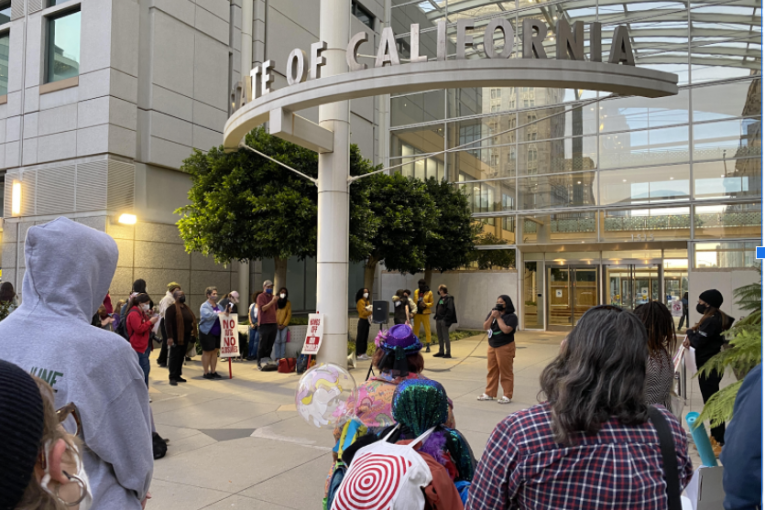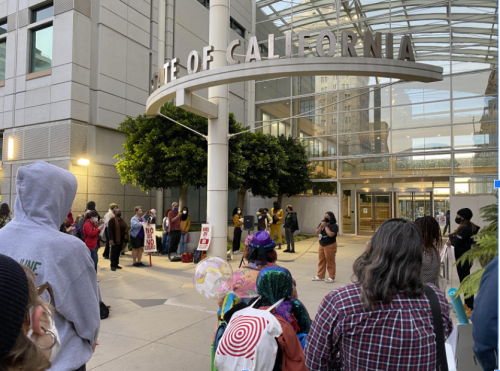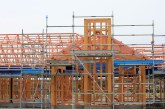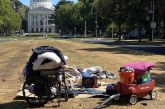

By Kimberly Bajarias
OAKLAND, CA – On Feb. 9, the Oakland Board of Education made a disheartening decision to close seven schools over the next two years due to alleged low enrollment and budget issues. Alongside protests and hunger strikes, community members organized in front of the California State Building on Feb. 17 to demand that the schools stay open, raising concerns for the endangerment and educational impacts of Black and Brown communities.
Natalie Gallegos Chavez, student board director for the Oakland Unified School District (OUSD), encouraged community solidarity and youth advocacy, proudly calling the children speaking up “little leaders.” In speaking about her Oakland community at large, she said “those are my people, that’s my community, and it’s who I represent.”
During the Board of Education’s meeting to vote on the school closure plan, Gallegos Chavez recognized that the board was voting to close predominantly Black and Brown schools during February–Black History Month. Many of the schools have a majority of Black students, and voting against the education of Black communities furthered a tension in race and class relations.
“We have two teachers who are on a hunger strike right now for our students, and they’re putting their lives on the line for us,” noted Gallegos Chavez, referring to Westlake Middle School teachers Maurice André San-Chez and Moses Olanrewaju Omolade.
As of Feb. 19, the teachers will be entering day 19 of their hunger strike, despite Omolade’s recent hospitalization. At the Board of Education’s special meeting on Feb. 18, the directors decided against postponing the school closures, prompting community members, teachers, and even students to go on their own hunger strikes.
Board Directors VanCedric Williams and Mike Hutchinson, who voted against the school closure plan, are allies to the community protests. According to Gallegos Chavez, “they have always been there to fight for us, and they always listen to us.”
When asked about the future of school closures in the Oakland community, Gallegos Chavez said that “it’s a history that keeps repeating, unfortunately.” Last year, the Board of Education tried to close schools down, but granted an extension due to COVID-19 recovery. Her elementary school was merged in 2007.
“Our youth and community, they always fight for each other,” stated Gallegos Chavez about the strength of Oakland.
Community members like Sarah Wheels, a fifth-grade teacher at Piedmont Avenue Elementary School, do just that. Her school is not affected by the closures, but she protested in solidarity on Feb. 17.
“This is not the first time that they have tried to close schools since I’ve been working in the district, and I haven’t worked here that long,” said Wheels.
Like other community members, Wheels noted that “it’s really racist and classist,” referencing the institutionalized racism and gentrification of closing predominantly Black and Brown schools. One of the goals of the community protests is to center Black and Brown communities in the fight to keep schools open. Many students from these communities come from underprivileged backgrounds, and the closures raised concerns about finances, transportation, and the search for new schools.
Although Wheels acknowledges that “being a teacher right now in Oakland is really hard,” she notes that the teachers “went on strike a few years ago. It looks like we might be going out again.”
Many people who are not from Oakland also protested on Feb. 17, like Aidan ByrneSarno and Eden Sharma. Both expressed disappointment in the Board of Education, the victimization of Black and Brown communities, and the privatization of public resources.
“It was a very common thing for governments to close down or take funding from public schools and put them into either charter schools or private schools,” said Sharma.
ByrneSarno added: “Nationwide, there have just been so many attacks, and I think that’s fundamentally a result of trying to privatize education from billionaires trying to get profits.”
Many of the speakers at the Feb. 17 protest addressed the idea that the Oakland Board of Education has provided little to no feedback, transparency, or explanation. The board directors who voted to close the schools attributed their decision to declining enrollment and financial concerns; however, opposing board directors claim these as lies.
As of the writing of this article, parents are threatening to take their children out of the school district, and community members are starting petitions to recall the board directors who voted in favor of the closures.
Kimberly Bajarias is a second-year student at the University of California, Berkeley.





https://time.com/6146541/oakland-schools-closing-enrollment/#:~:text=Five%20years%20ago%2C%20there,merge%20nearly%20a%20dozen%20schools.
https://www.ppic.org/publication/declining-enrollment-in-california-schools-fiscal-challenges-and-opportunities-in-the-coming-decade/
This trend will also further decrease the demand for college.
Not if we grow our college enrollment by increasing full-tuition international and national students from outside California. All of whom will need housing! Another of the ‘privileges’ of living in a college town 😐
It might decrease the demand for some colleges in some places. Expecting UC enrollment to drop anytime in the next couple of decades is probably not wise.
Demand is dropping overall (and nationwide), and has been for years.
As you noted, the UC system is attempting to take a bigger piece of an overall smaller pie. Your citation regarding the following is interesting:
Fewer Students Mean Big Trouble For Higher Education : NPR
Mergers often occur in industries which are declining, as well. (Again, an example of a “bigger piece of a smaller pie”.)
The increased percentage of college graduates from a “UC” will likely decrease its comparative value.
Pretty soon, the question won’t be “which college did you attend”? Instead, it will be “which UC did you attend”?
They’ve already done-away with SATs.
Irrelevant to UC overall and irrelevant to UCD specifically, therefore not a useful data point for the city of Davis or our region with respect to growth and planning issues.
Perhaps, if you support the goal of the UC system as you quoted:
But at least they’re also looking to possibly expand into the college (facilities) which are failing, as you noted. Makes sense, given the goal.
But one might question if they’re doing that primarily for their own survival, in a declining enrollment environment. (Essentially, the same form of “poaching” of students that school districts such as Davis’ and Piedmont’s are attempting. Which seems primarily driven out of self-interest.)
Of course, like Piedmont, they can attempt to use the “diversity” argument, rather than acknowledge any self-interested goal.
It all goes back to a bigger piece of a smaller pie.
Of course, they use the “quality of education” argument in their defense, as well.
But sometimes, folks use that to denigrate particular campuses within the UC system itself, which causes their entire argument to start unraveling. Again, this seems to be driven by other motives (or perhaps underlying elitism).
For sure, you don’t want to tell a college town (or university system) that their industry is declining. You’ll get all kinds of pushback, sometimes rather aggressive in nature. (Same with school districts, and those associated with them.)
In my parents’ time, college graduates were comparatively rare. But it wasn’t required, to get a good job. (More so for white males, no doubt. Women were needed at home, to take care of unreasonably large families.)
Today, everyone is expected to go to college.
In the future, everyone and their grandma will have a degree from a UC. Despite reduced overall demand for college, and decreasing value of said degree. (Particularly in fields in which there isn’t much demand in the working world.)
“Wheels noted that “it’s really racist and classist,” referencing the institutionalized racism and gentrification of closing predominantly Black and Brown schools.“
Those school districts are not the only ones facing declining enrollment, as noted in the articles I posted.
To build on that theme, all four schools I referenced (below) that were closed were in White-O-Alto.
Wow, hunger strikes and little leaders. Good luck with all this he says doubtingly. My early school days were filled with fights to keep schools open due to declining enrollment. Every school I went to as a child is closed — four total — and two the land doesn’t even exist anymore, they are housing developments.
How exactly do you ‘lie’ about enrollment numbers? I’d thought that’s one statistic that is pretty easy to confirm.
The article I posted includes an interactive map, which shows where further declines are expected to occur over the next 10 years. The decline appears to be concentrated in counties that are primarily “white”.
Enrollments in Yolo county are projected to decline by 6%.
Overall, statewide enrollment is projected to fall by an additional 7%.
https://www.ppic.org/interactive/changes-in-k-12-enrollment-across-californias-counties/
Piedmont is now encouraging enrollments by students from Oakland, due to Piedmont’s own declining enrollment. They claim that the reason they’re doing so is to increase diversity, but there appears to be a more self-interested reason for their action:
https://www.sfchronicle.com/eastbay/article/Why-Piedmont-s-academically-elite-schools-are-16843048.php
Can we just ban school districts actively recruiting for out-of-district students?
Perhaps Scott Wiener can champion that issue?
It does hurt those “left behind” (in their normally-assigned districts), who are probably disproportionately students of color.
From Vanguard article, above:
From the link provided:
Wow – that, my friends is one heck of a commitment to a job. (I see that Westlake is one of the schools scheduled for closure, so apparently these two would lose theirs.)
Let’s see if they go through with the hunger strike until the “end”. (I hope not.)